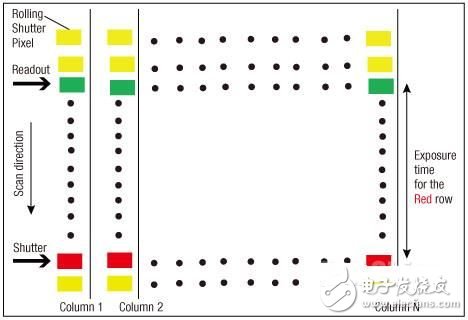Application of Global Shutter Pixel Technology on CMOS Image Sensors
Traditionally, global shutter pixel technology has been predominantly used in CCD image sensors. However, with the growing popularity of CMOS image sensors and the increasing demand for high-quality imaging of fast-moving objects in fields like machine vision, film production, industrial automation, automotive systems, and scanning, ApTIna has been working to adapt global shutter technology for CMOS platforms. This effort aims to overcome long-standing challenges associated with implementing global shutter in CMOS, such as limited pixel size, reduced fill factor, and higher noise levels. The new global shutter technology offers smaller pixel sizes, improved fill factors, enhanced gain sensitivity (GSE), lower dark current, and reduced noise, making CMOS sensors more competitive and viable alternatives to traditional CCDs.
Rolling shutter technology, also known as focal-plane shutter, works by sequentially resetting and reading out rows of pixels. A shutter pulse resets a row of pixels before it is read out, and the time between the reset and readout pulses determines the exposure duration. However, because each row is exposed at a slightly different time, rolling shutters can cause distortion when capturing fast-moving objects, making them unsuitable for applications like barcode scanning, machine vision, or automated inspection systems that require accurate and distortion-free images of moving targets.

Figure 1: How the typical rolling shutter works
Many photographers and videographers have noticed that with rolling shutters, especially in certain cameras and camcorders, the entire image isn't captured at once. Instead, the sensor scans the image line by line, either vertically or horizontally. This can lead to issues like skewed perspectives or motion artifacts in dynamic scenes. One benefit of rolling shutters is their ability to continuously collect light during exposure, which can improve low-light performance. However, under challenging conditions—such as fast movement or flash lighting—rolling shutters can introduce visible distortions, including smearing, wobbling, and partial exposure.
Historically, there have been efforts to transition from rolling to global shutters. However, early attempts faced significant obstacles. Adding memory cells to support global shutter functionality often reduced the active photosensitive area, negatively impacting quantum efficiency. Additionally, at the time, factors such as semiconductor limitations, application requirements, market demand, and cost made it difficult to justify the development of such technology. As a result, progress was slow, and many projects were abandoned due to the lack of clear feasibility and commercial viability.
Ceramic Guides For Sale,Al2O3 Ceramic Guides,Custom Ceramic Guides,Ceramic Guides Rod
Yixing Guangming Special Ceramics Co.,Ltd , https://www.yxgmtc.com